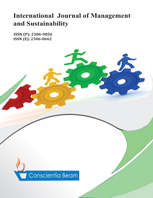The Role of Intellectual Capital in Firms’ Performance and Market Value: Evidence from Jordan
DOI:
https://doi.org/10.18488/11.v11i4.3232Abstract
The purpose of this study is to examine the association between intellectual capital efficiency and firms’ financial performance and market value. The study employs the value-added intellectual coefficient (VAIC) model to measure intellectual capital efficiency. This model consists of three elements: human capital efficiency, structural capital efficiency, and capital employed efficiency. The study uses the return on assets (ROA) ratio to measure firms' financial performance and the market-to-book value (MBV) ratio as a measure of market value. Data for a sample of 113 manufacturing and service companies listed on the Amman Stock Exchange for 2014 to 2018 were analyzed using multiple regression analysis. The results indicate that VAIC has a significant positive relationship with a firm’s financial performance, while it is unrelated to a firm’s market value. Human and structural capital also have a positive influence on financial performance, but they have no relationship with market valuation. Capital employed is positively related to both financial performance and market value. The findings of this study would enable companies to better understand the role of intellectual capital in adding value for all stakeholders of the company. They may also bring standard setters’ attention to the need for recognizing or disclosing intellectual capital either quantitatively or qualitatively within the accounting financial reports, which may have the potential to increase the credibility of financial reporting.

